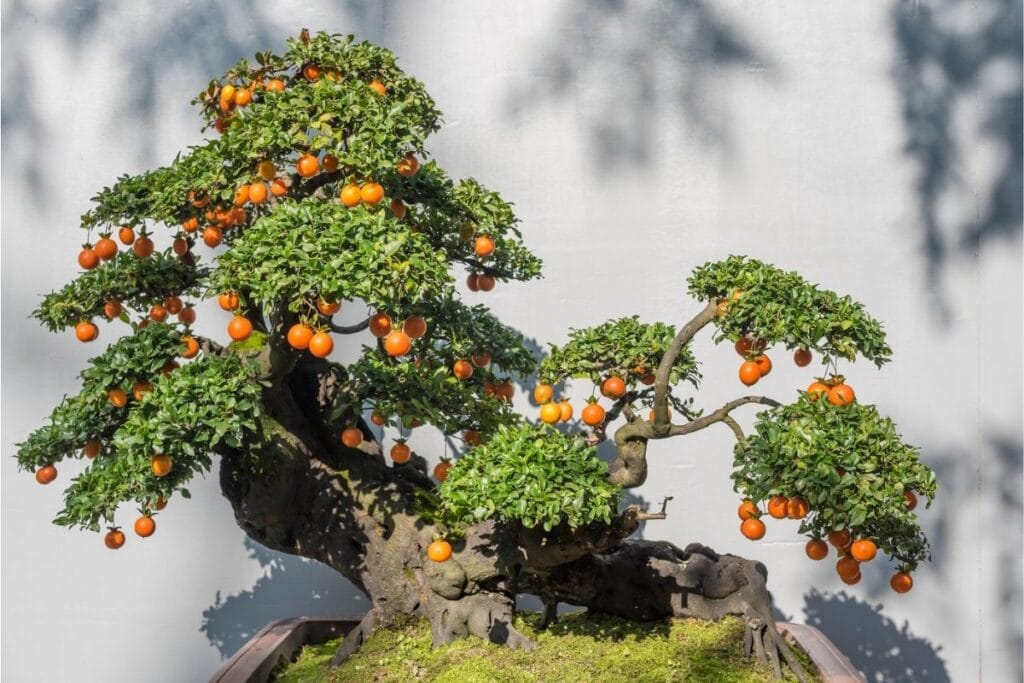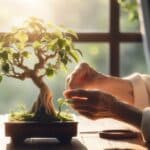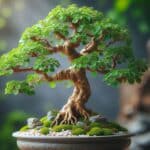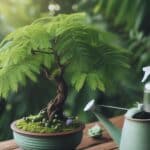If you have always assumed that bonsai trees can only be grown for their lovely flowers and interesting root systems, you wouldn’t be alone. In fact, many people grow bonsai specimens for these purposes alone.
But did you know that you can also grow fruit trees for bonsai? While they’ll require significantly more maintenance than their full-size counterparts, there are many different kinds of plants you can grow with the right know-how.
Here are some tips.
Types of Bonsai Fruit Trees
Technically, any tree species can be used to grow a bonsai, and that includes fruit trees. However, there are some that perform better than others if you’re in the market for a fruit tree bonsai.
Some of the most popular include crabapples, cherries, and citrus trees.
Apples

Crabapple bonsai tree (Malus) are some of the most popular fruiting bonsai trees because they not only produce fruits but they also have gorgeous blossoms and leaves. Some cultivars to consider include ‘Calloway’ and ‘Harvest Gold.’
These two bonsai apple trees offer edible fruits along with white blossoms in the spring and crisp gold leaves in the fall. Japanese winterberry
Cherry
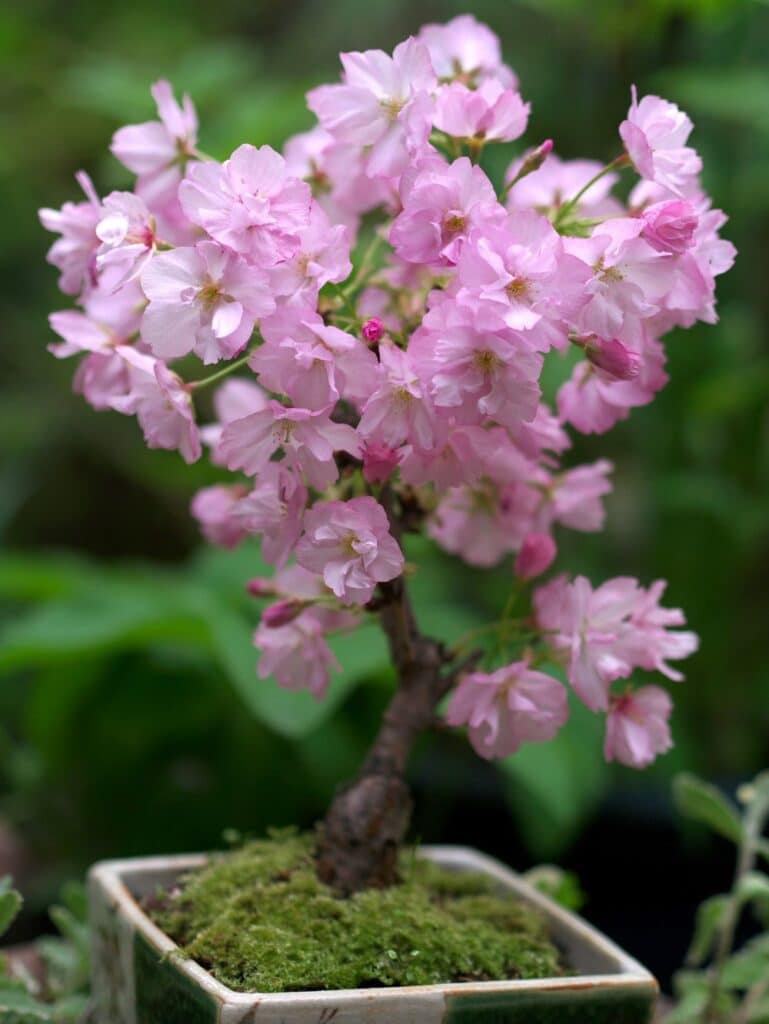
The cherry tree (Prunus) is another great option to consider if you’d like to be able to harvest fruits from your bonsai tree. Just make sure you pick the right cultivar. While any kind of cherry tree can be used for bonsai, the best are those with edible small fruits and gorgeous foliage. ‘Bright n Tight’ is one such option, an evergreen tree that has lovely spring flowers that evolve into dark black cherries.
Lemon
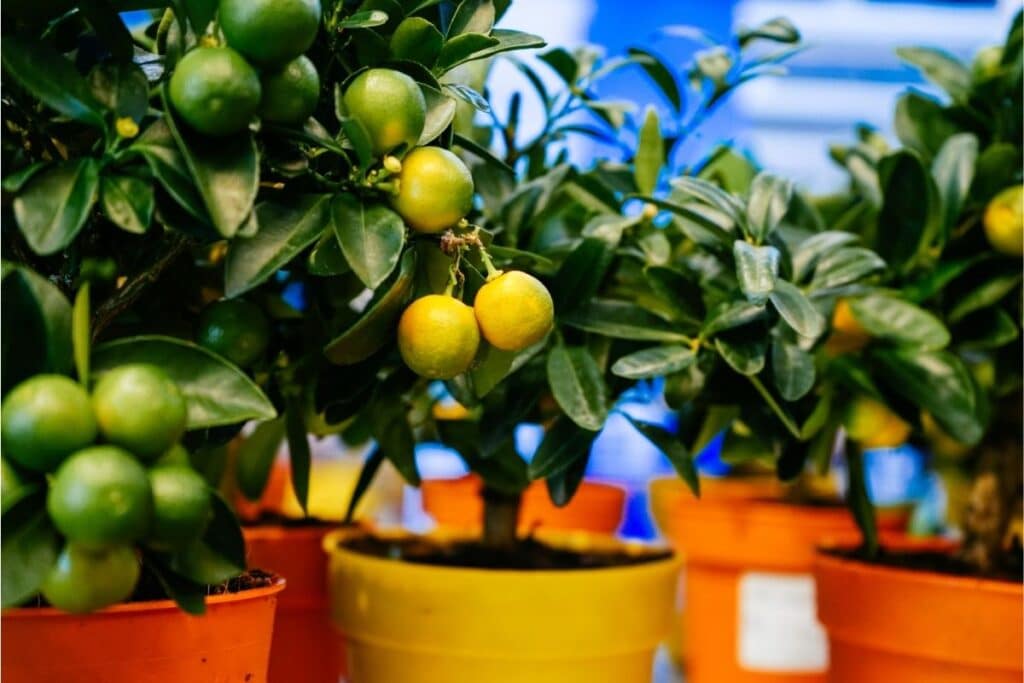
Meyer lemon trees (Citrus × meyeri) are often grown indoors, making them a smart choice as a bonsai. Known for their fragrant blossoms and miniature fruit, Lemon tree bring a touch of freshness and vitality to any bonsai collection.
Lemon bonsai trees are not only offer full-size lemons but can be grown year-round indoors, even in cooler climates.
Pomegranate
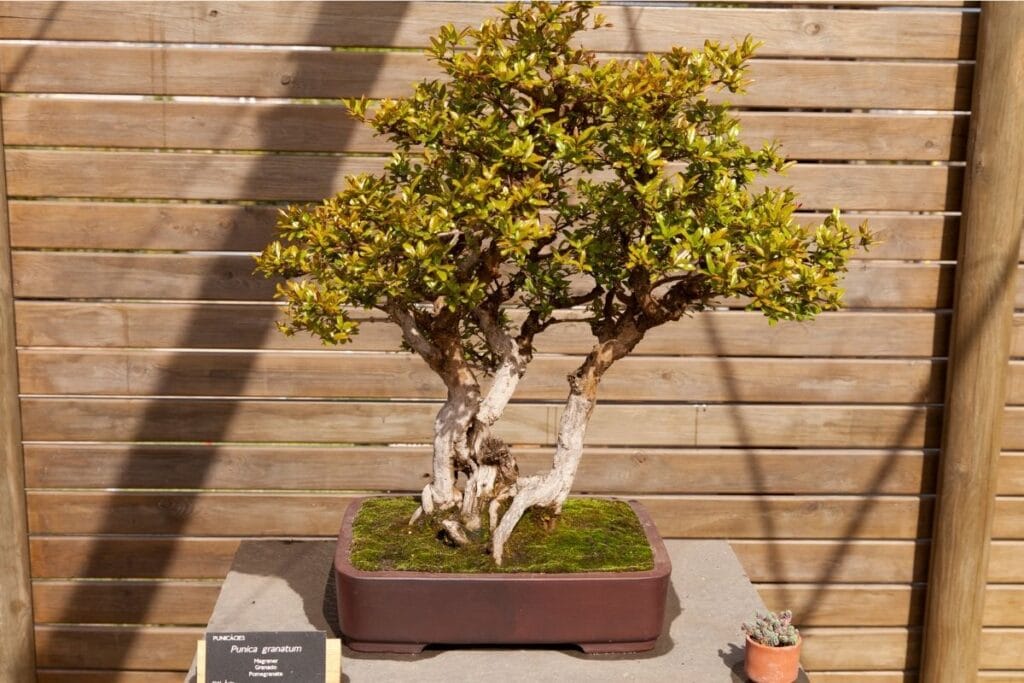
Pomegranate bonsai trees (Punica granatum) are deciduous and very popular as bonsai specimens. They drop their leaves in the fall along with large edible fruits and trunks with attractive bark.
American Persimmon
The American persimmon (Diospyros virginiana) can be grown as a bonsai, too. They are similar to other bonsais in their maintenance needs and only need to be repotted every other year or so since they grow quite slowly.
Calamondin Orange
Calamondin orange trees (Citrus x microcarpa) are cold hardy to 20 degrees, among them a good choice not only for bonsai gardeners but also for those who live in cooler growing zones. At its full size, the calamondin orange tree grows to heights of up to 20 feet. However, it can also be propagated and pruned as a bonsai. The oranges are smaller than what you might find on a traditional bonsai, only reaching around an inch in diameter.
Learn more about bonsai orange tree.
Olive Trees
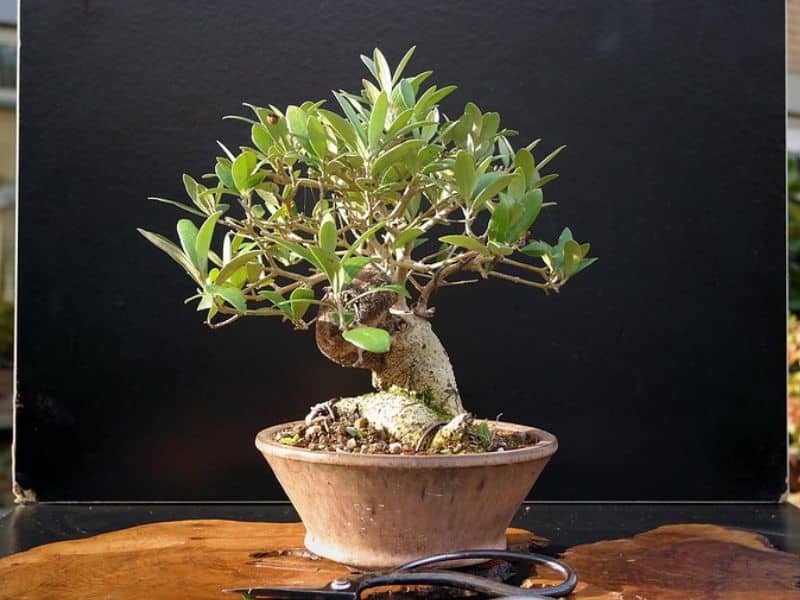
Olive trees (Olea europaea) are excellent choices for bonsai, known for their resilience, small leaves, and distinctive gnarled bark.
Native to the Mediterranean, these tiny trees adapt well to pruning and various bonsai styles, developing a beautiful, aged appearance over time.
Olive trees in bonsai form offer a visually striking and captivating display. With their small, silver-green leaves, gnarled trunk, and delicate branches, Olive bonsai showcase a sense of age and character.
Their aesthetic appeal is heightened during the growing season when small, fragrant white flowers and tiny olives can adorn the tree, adding to the overall charm of this iconic bonsai species.
Red Currant Trees
Red currant trees (Ribes rubrum) offer a unique and charming addition to bonsai collections, blending the beauty of bonsai cultivation with the appeal of small, vibrant berries.
Their delicate, lobed leaves and intricate branching patterns make them suitable for various bonsai styles, including the informal upright or cascade styles. Beyond their ornamental value, the miniature red currants add a delightful touch of color and interest to the bonsai, making them both visually appealing and potentially productive.
Remember that this bonsai tree was once prohibited in several states to reduce the spread of certain diseases and fungal infections among other tree species.
Mango trees

Mango trees can be cultivated as bonsai, creating a miniature version of the tropical fruit tree for indoor enjoyment. While not a traditional bonsai fruit tree, mango’s small leaves and manageable size respond well to shaping techniques.
These miniature mangoes can flower and produce tiny fruits, adding to their charm. However, their tropical nature and vigorous growth require specialized care for bonsai enthusiasts.
Growing Fruit Trees for Bonsai from Seed or by Propagation
One of the easiest ways to cultivate new fruit trees for bonsai is to do so using cuttings. You can also grow them by seeds but this takes a year or more and some serious patience!
Take your cuttings during the spring or summer. There are some hardwood cuttings that can be prepared or planted in the late summer but earlier in the year is usually best.
You can prune just a few branches from the tree that you select, pruning at a 45 degree angle with a sharp set of shears. Put your cuttings about an inch into the soil, then water thoroughly, keeping the soil moist. Your cuttings should start to grow in a couple of weeks.
How to Care for Bonsai Fruit Tree
Here’s our bonsai care guide:
Sunlight
While you can grow many of these bonsai fruit trees outdoors, in all likelihood, you’ll be growing them inside. Because of this, it’s imperative that you make sure your tree gets proper sunlight. A sunny window or supplementation with grow lights is ideal. You may also want to consider putting your bonsai outside during the summer months, if it is warm enough where you live, to allow it to get access to natural sunlight for at least part of the year.
Watering
Well-drained soil is essential for all bonsai, but especially fruit trees. Don’t let the soil dry out completely but also do not allow water to sit at the roots. Water it from the bottom, watering regularly. Some fruit trees may need to be watered once a day while others will require twice daily watering.
Fertilizing
Feed your fruit tree bonsai regularly to make sure it receives all the nutrients it needs to grow well and to set fruit. You should fertilize twice a month during the growing season, stopping only during produce fruit period. In the winter, you can fertilize just once every couple of months. (See our bonsai fertilizer review for more details).
Potting and Repotting
Repot your fruit-bearing bonsai every two to five years. This will vary depending on the type of fruit tree you are growing. You’ll know your tree is ready to be transplanted into a new pot when you notice that it is fruiting or blooming poorly. This indicates that it may be becoming rootbound. To repot, lift the plant out of hash oil, cut two thirds of the root mass from the plant, and then put it into a new pot so it has more room to grow.
Pruning Fruit Tree Bonsai
Pruning is important for all bonsai trees but especially for fruiting bonsai trees. You should do this in the fall, after the tree has gone dormant, or before it blooms in the spring. You can also defoliate int during the growing season by removing new shoots that occur. This will encourage the tree to stay small.
Pests and Diseases
For the most part, the pests and diseases that plague your fruit tree bonsai will be specific to the type of bonsai you are growing. For example, citrus longhorn beetles are common on citrus plants, while cedar-apple rust is common on crabapple and apple trees. Pay attention to your plant’s health and monitor for signs of pest infestation, such as defoliation or a failure to thrive. Treat with insecticides or organic treatments as needed.
Where to Buy Fruit Tree Bonsai
Because bonsai is not some sort of genetically altered plant to create a dwarf version of a full size species, you can purchase fruit bearing bonsai just about anywhere and then carefully prune, cultivate, and we are the branches. This will allow you to keep it under four feet and still bear fruits. Any fruit plant with a woody stem can be cultivated in bonsai, so check your local gardening store for options.
FAQs
Can you bonsai a coconut tree?
Technically, no. True bonsai require branching and regrowth, which coconuts lack. However, you can create “coco bonsais” by dwarf varieties and careful root/leaf management, though they won’t have the classic branching structure.
Why are there fruit flies on my bonsai tree?
Fruit flies may be attracted to your bonsai tree if there is decaying organic matter, such as overripe fruit, soil with excessive moisture, or accumulated debris in the pot. Ensuring proper watering practices, keeping the area clean, and promptly removing any decaying material can help mitigate fruit fly infestations on your bonsai tree.
Are bonsai fruit edible?
Yes, most bonsai fruits are edible, like tiny versions of their full-sized counterparts. But their taste might be milder, and they’re often treated with non-food-grade chemicals, so caution is advised.
See more:
*image by LP2tudio/depositphotos

